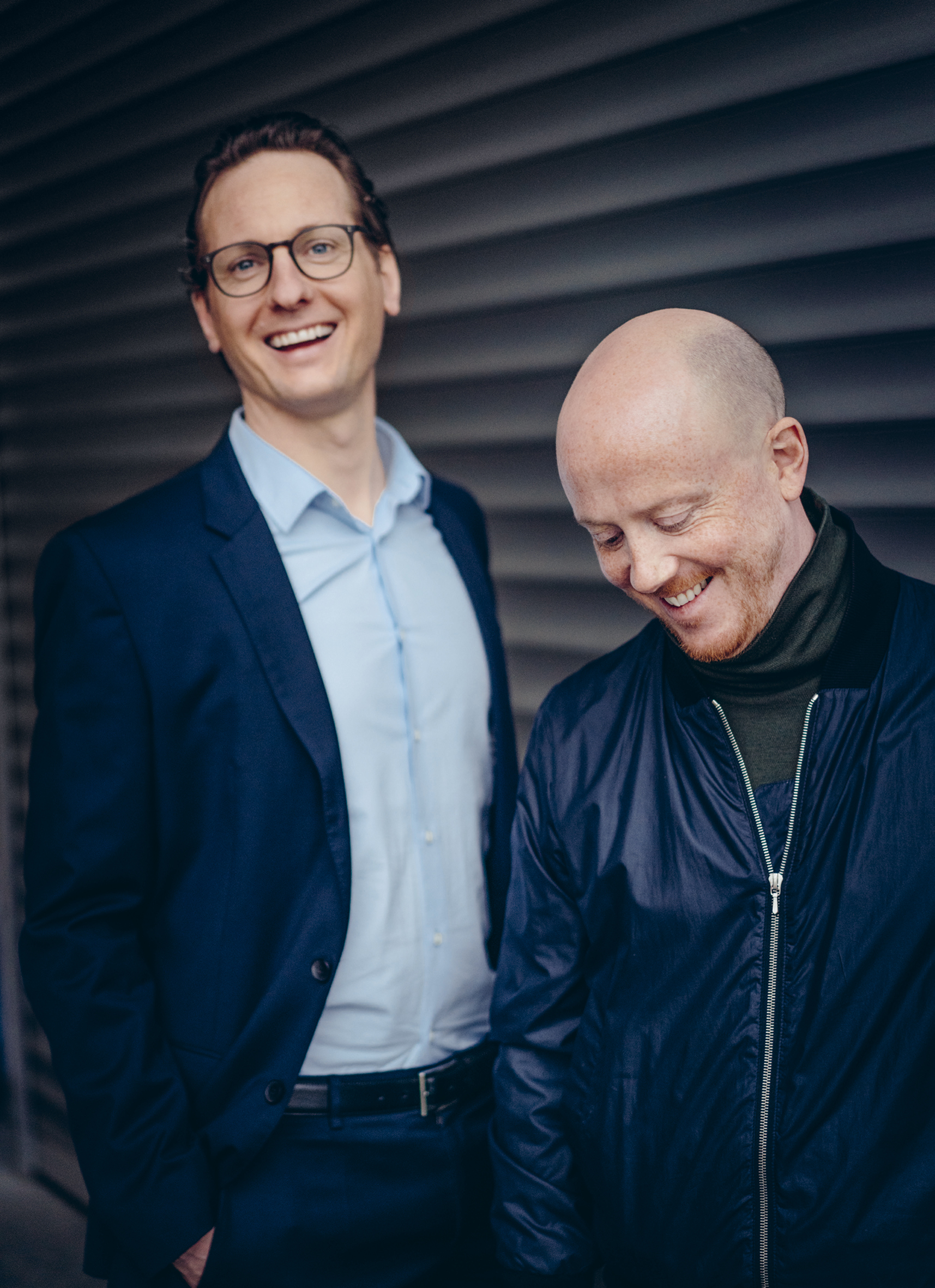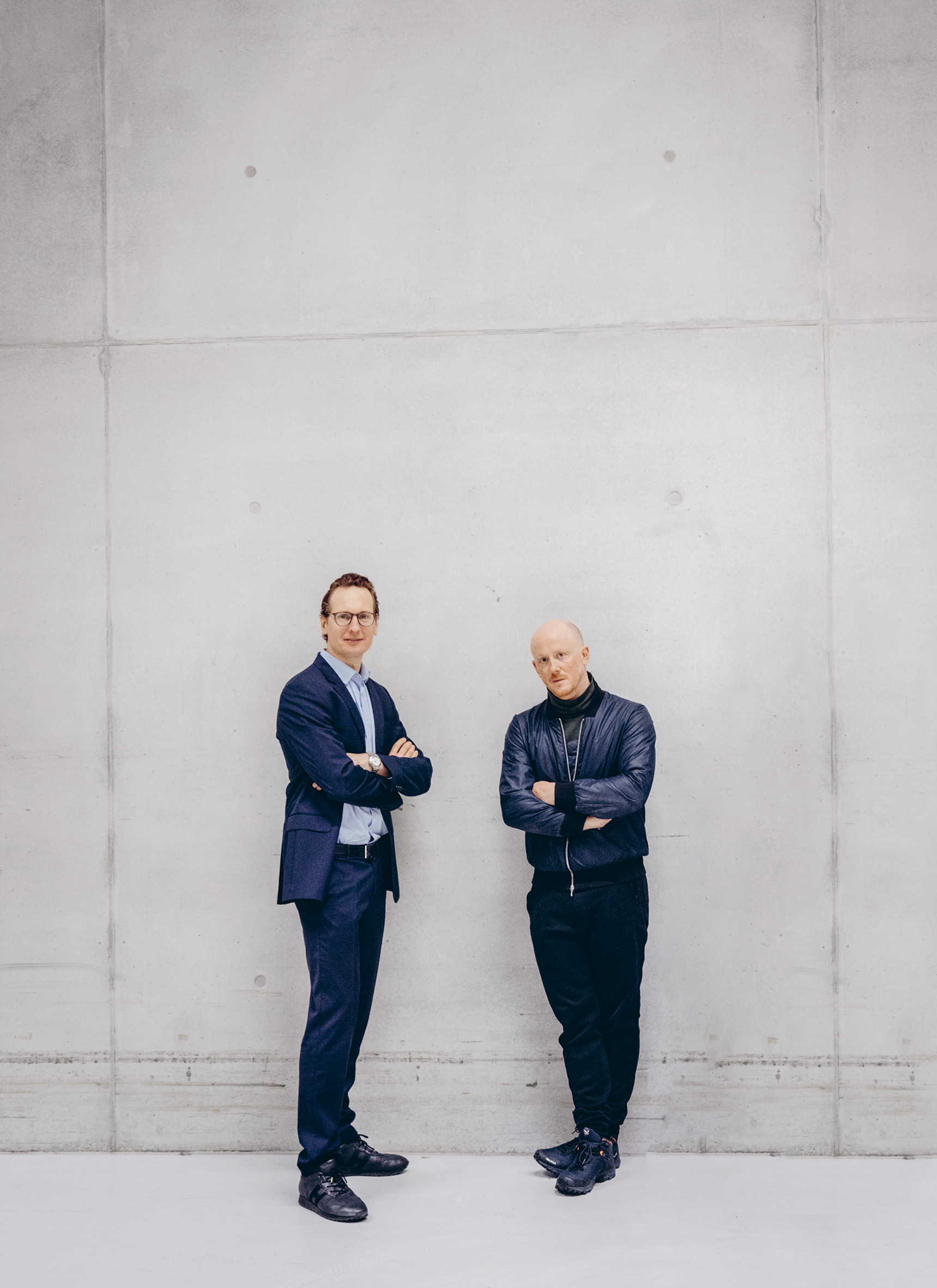Bringing
something
new into
the world
Dr Marc Brunner & Steffen Kehrle
A conversation about collaboration. With Dr Marc Brunner—co-CEO of the Brunner Group—and Steffen Kehrle—designer and creative mind behind ASK, Atelier Steffen Kehrle.

Mr Brunner, your parents, Helena and Rolf Brunner, founded the company in 1977. Your father’s employer at the time had dismissed a customer enquiry as impossible to realise; your father accepted the order and successfully completed the project. This step established a legend around Brunner’s foundation, expressed in the philosophy of Making the impossible possible that became part of the company’s image. You yourself joined the management team in 2004 and, as the founder’s older son, represent the second generation in the company. Is Making the impossible possible a heavy burden for the future, or is it an easy path to tread?
M
B
No, it’s not a burden. It’s our philosophy and our goal. Very far from being a burden, it’s the force that constantly drives us onwards. You could say that we spend every day considering how we can redraw the boundaries of what’s possible. Be it in terms of technology or engineering, design or materials, all of us spend every day working out how to expand the scope of our design. And we all pursue the goal of reaching excellence in everything. My father embraced responsibility and made the leap into self-employment. His spirit and his customer-centric mindset have remained Brunner’s core values to this day. In the second generation, we’ve now further expanded this perspective to include product development and innovation, but at heart the issue is always the same: how can we add something that doesn’t even exist in that form yet? Quite simply, we want to create the best furniture in the world for selected niche markets.
-
-
-
-
How do you manage to take the right decisions? How do you decide which developments to accept or reject?
M
B
We’ve always had the courage to try things out. Some worked, some didn’t. Failure is also an integral part of our philosophy.
-
-
-
-
Launching a new product is always a risk. At what point can you be sure whether the risk has been worthwhile?
M
B
It’s not always clear whether a product will be successful; it takes time. But we have a feel for it. When we—that’s me, my brother, who works in our sales department, and my father—when all three of us look at how a project is developing and all three of us get a good feeling, the project has a pretty good chance of being a success.
-
-
-
-
Can you describe that feeling? A combination of sales expertise, customer focus, production know-how, familiarity with the market and an entrepreneurial sixth sense?
M
B
Yes!
S
K
It’s energy!
-
-
-
-
And what was it like with nate?
M
B
I think nate is probably a prime example in that respect, including for us. We had to make a lot of decisions with uncertain outcomes.
S
K
It was the scope of the project that made it so special. Usually what happens is that you first make a chair, then perhaps a table. So far, so normal for a lot of companies. But we made an entire product family from scratch. That’s unique. What we did here, with lots of brilliant input–particularly from the development department—was to suddenly unveil 27 products all at once. That could only happen here at Brunner.
M
B
That was the first time we’d done something like this with so much consistency and purpose. There are probably few others in our industry that could do the same.
-
-
-
-

How did that come about?
M
B
We wanted to create the wooden chair of the future, a chair that forged new paths and wasn’t merely based on existing designs. For us, good design is the interaction of aesthetics, function and construction, exploring the technical possibilities while maximising quality. Brunner isn’t a manufacturer that relies on form alone. We don’t call in some designer to sketch out a couple of lines and then there’s your chair, whatever the cost. That’s a completely different approach and it’s one that has its place, but that’s not the way we design products. Our furniture always has to work; it has to be comfortable to sit on, it has to be saleable. These are premium products in terms of quality, and they’re certainly not the cheapest, but neither are they luxury goods where price is no object. This understanding forms the basis for our development process and our collaboration with designers.
S
K
The collaboration over nate was a very intense process. The plastic frame was a particularly new idea for all of us. I remember standing in the development studio for our presentation, with the whole Brunner family in front of us. At some point someone asked me, ‘So is that a wooden chair?’ And I replied, ‘I don’t know, but it’s certainly a Brunner chair.’ At that moment it was clear we were on the right track.
-
-
-
-
A kind of making the impossible possible moment?
S
K
Yes, I’d say so. Whenever I came into Brunner, I could feel how belief in the project was growing all through the company. People were coming up to me and saying how great it was, what we were doing. We got equally enthusiastic feedback from the designdirector—and from Marc, Philip and Rolf Brunner...
-
-
-
-
...Sounds like a fascinating corporate culture. What does this team-focused collaboration mean for you, Mr Kehrle? Don’t you end up delegating a lot?
S
K
The process and the challenges take centre stage for me. The greater the challenge, the more interesting I find it, and the better my team can perform. And that performance is what’s called for here. Every time we’re here, it’s obvious that something has to happen. Development, not design, is our remit. We develop the products together, everyone with their own task. Of course, I’m ultimately responsible for making sure it all works. But when you look closer, at the end of the day my studio and Brunner have merged into one enormous team.
-
-
-
-
Making everything work is down to both sides. Nobody dominates over anybody else, but at the same time the roles need to be clearly assigned. How do you approach this very modern way of working?
S
K
We rely on each other. If the tabletop has to be 16 millimetres thick, then that’s what it will be, even if I’d prefer 10 millimetres thick. If I have an idea but the product doesn’t work, the idea goes in the bin. Sure, there were one or two years with some bumps in the road. But now we’ve built up a lot of understanding and a lot of mutual trust.
-
-
-
-
Mr Brunner, what about the other designers you work with? Have you turned the working style you described into a systematic method?
M
B
To state a general principle, we genuinely want to build collaborations with the designers. So what matters is how we define authorial design. The great master up in his ivory tower, sketching designs and handing them to the supplier or manufacturer to produce? That doesn’t work for us. It’s always about dialogue, a back and forth, an iterative process. So it’s really important to have an open mindset, and that goes for our designers too. What we absolutely don’t need is someone who lays down the law and says, This is the only way to do it, and I know it all.
-
-
-
-
Please select an offer and read the Complete Article Issue No 12 Subscriptions
Already Customer? Please login.
